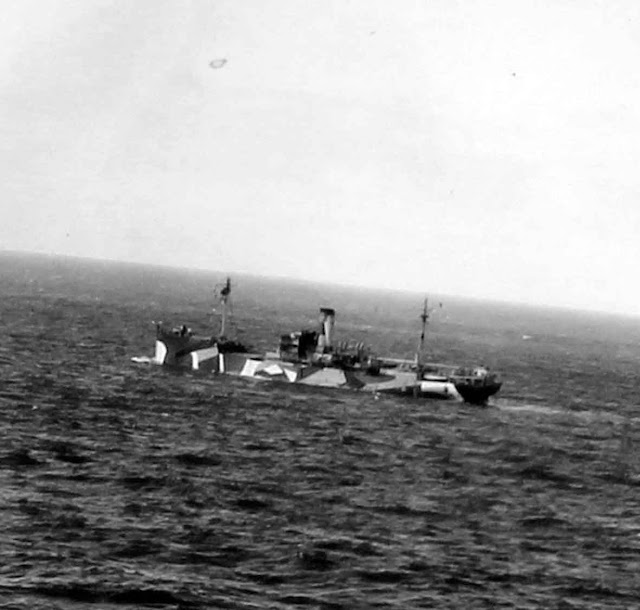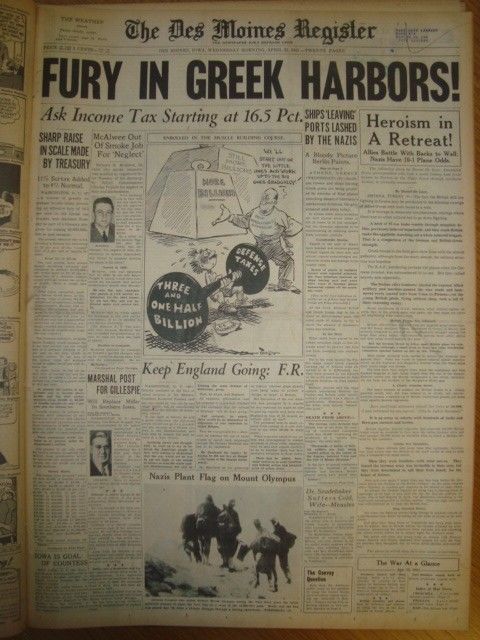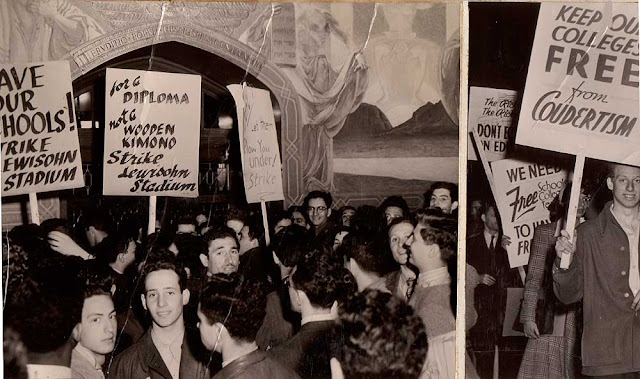Italian/Greek Campaign: Except for local gains, the Greek offensive basically has ground to a halt by
27 December 1940. The Greek government and military commanders assess the situation to see if perhaps now it is time to go over to the defensive. The weather in the mountains simply is too brutal at this point to facilitate major advances. To the credit of the Greek forces, they have secured strong defensive positions, with V Army Corps taking Mount Tomorr and establishing a connection between II and III Corps, which have been blocked by the Italians in the valleys below. Greek I Corps captures Kalarati and Boliena in the coastal sector.
There are rumors in the press that "an Italian peace commissioner" is "seeking a discussion" with the British for an armistice. The press theory is that Italy is trying to force Germany to help it out militarily by threatening to surrender. This brings up another, more ominous development: possible German involvement in the Balkans and North Africa. A perceptive UPI analysis piece is picked up by news services around the world. An example is one on page four of the San Bernardino Sun's 27 December 1940 edition, placed under the banner headline "Mystery Attached to Movement of Huge German Army Through Rumania." It continues:
REASONS FOR [GERMAN] ACTION UNDISCLOSEDSeveral Courses Open, but All Dangerous for Germany and Axis Partner Italy
By J. W. T. MASON (United Press War Expert)
Reports from Budapest that Germany is moving between 20 and 30 fully equipped divisions into Rumania through Hungary have no basis in known facts of any new conditions in southeastern Europe. If the reports are true, they would imply the sudden development of a critical situation facing the axis with Germany being called upon to try to readjust it. An army as large as the Budapest reports describe would be sufficient for the first phases of a thrust through Bulgaria against both Turkey and Greece. But it was recently announced that demobilization of the Bulgarian army had been ordered, which could scarcely have occurred without assurances that the axis did not intend to invade Bulgaria. It is possible that Italy has secretly asked Herr Hitler to create a double diversion in the Balkans, hoping to lessen Greek pressure in Albania and British pressure in Libya. A German military concentration in Rumania, threatening Greece and the Dardanelles, might disturb Greek strategy.
Of course, there most definitely are German troop movements in Romania, though not necessarily of the scope reported in the article. They are heading for Bulgaria as part of Operation Marita - it remains unclear to the Germans at this point if they will invade Yugoslavia as well. And, the author of the piece is absolutely correct when he states that the German troops "might disturb Greek strategy."
 |
| Part of today's article in the 27 December 1940 San Bernardino Sun recounting German troop movements through Romania. |
European Air Operations: The Luftwaffe returns to the attack, bombing London with 108 bombers over the course of four hours overnight. There is heavy damage in the City and Whitehall, with 141 deaths. Damage is concentrated in certain neighborhoods such as Islington.
RAF Bomber Command counters with a strike by 75 bombers against an aircraft factory at Bordeaux.
RAF No. 252 Squadron receives the first Beaufighter to be delivered to a coastal fighter squadron.
 |
| The plaque at Tower Hill for the Araby. Only victims actually buried at Tower Hill are listed on the memorials there. One crewman was cremated at Glasgow, another buried at a Roman Catholic cemetery. |
Battle of the Atlantic: Prime Minister Churchill asks the First Sea Lord, Admiral of the Fleet Sir Dudley Pound, whether merchant ships, particularly tankers, can be converted to launch "expendable aircraft" (which apparently means battle-worn Hawker Hurricanes) from catapults (as from battleships and cruisers) for convoy protection. This indeed is possible, and such craft first are called Auxiliary Fighter Catapult Ships, and later become known as Catapult Aircraft Merchant ships (CAM ships). The Hurricanes carried by the CAM ships become known as "Hurricats" or "Catafighters" or "Sea Hurricanes."
Following its abortive attack on Convoy WS 5, Admiral Hipper makes port at Brest. Is is the first major Kriegsmarine warship to reach any of the French ports. This concludes Operation Nordseetour, the codename for Hipper's raiding expedition. Nordseetour must be adjudged only a partial success because Hipper sank only one ship of 6078 tons during the entire cruise - but its mere presence in the Atlantic jumbled Royal Navy deployments and kept the Admiralty wasting men and ships on fruitless searches in both the North and South Atlantic. In addition, it now is in position to sortie out into the Atlantic at will and also preoccupy RAF Bomber Command, drawing bombs away from other targets. Thus, saying that Operation Nordseetour is "unsuccessful" as many do is untrue - it simply is not as successful as it might otherwise have been. Getting Admiral Hipper to the Atlantic coast ports is a strategic gain for the Kriegsmarine.
Meanwhile, heavy cruiser Admiral Scheer remains in the Atlantic, meeting with German raider Thor and supply ships Nordmark and Duquesa (captured) east of St. Helena.
The German coastal guns at Cap Gris Nez shell British convoys off Dover and score some rare successes, hitting and damaging 530-ton Royal Navy armed trawlers HMT Blackthorn and Deodar.
U-38 (Kptlt. Heinrich Liebe) torpedoes and damages 4980-ton British freighter Ardanbhan in Convoy OB 263 in the Northwest Approaches. The freighter and its 40-man crew are left for dead in the water. About 13 hours later, Italian submarine Enrico Tazzoli (TZ) comes across the Ardanbhan and sends it to the bottom. Everybody perishes in the frigid seas.
Meanwhile, shortly after midnight on the 27th U-38 comes across the abandoned 12,823 ton Waiotira, which U-95 torpedoed on the 26th and left for dead, and sinks it. There is one death on the Waiotira, with 89 survivors.
U-65 (K.Kapt. Hans-Gerrit von Stockhausen) torpedoes and sinks 5455-ton Norwegian freighter Risanger east of the Cape Verde Islands. After stopping the ship with one torpedo, the U-boat surfaces and finishes it off with the deck gun. All 29 men aboard survive.
British 4936-ton freighter Araby hits a mine and sinks about 1800 meters west of Nore Light Vessel near Southend. There are six deaths.
British 449-ton freighter Kinnaird Head hits a mine and sinks in the Thames Estuary north of Sheerness. There are six deaths.
An RAF Hudson bombs and sinks 1200-ton Norwegian freighter Arnfinn Jarl at anchor off Egersund, Rogaland. However, the freighter is not badly damaged and sinks in shallow water, so it can be refloated and repaired. As with many ships sunk in World War II, this ship bears the name of a similar freighter sunk during World War I. The attack on Egersund is one of half a dozen attacks on shipping launched during the day by Coastal Command, which reports other successes which have not been confirmed.
British 2284-ton freighter Lady Connaught hits a mine and is damaged in the English Channel. However, she makes it back to port.
British 1641-ton freighter Victoria hits a mine and suffers damage in the River Mersey. However, the Victoria makes it back to port.
The Luftwaffe bombs 4668-ton Dutch tanker Woensdrecht, damaging it.
Convoy FN 368 departs from Southend, Convoy 372 and 373 depart from Methil, Convoy BN 12 departs from Bombay, Convoy BS 11B departs from Suez.
 |
| Memorial at Tower Hill for SS Waiotira. |
Battle of the Mediterranean: Weather in the Mediterranean Basin is especially severe, heavy storms blowing cold winds all across the region. It is turning into the coldest month in 17 years. In Malta, it rains for 36 hours straight, and morale is so poor that the military offers another extra rum ration.
Cairo signals "No change" in the battlelines. With military operations at a standstill again - the Italians are defending Bardia and Tobruk, while the British are bringing up Australian troops to launch assaults on them - the British begin strategizing over the next steps. A big meeting is planned in Cairo between General Wavell, General O'Connor and Major General Iven Mackay, commander of the 6th Australian Division currently deploying to launch an assault on Bardia.
Battle of the Pacific: Having futzed around in the general vicinity for a week - including an abortive attempt to lay mines near Rabaul on 24 December - German raider Komet returns to Nauru today. At 05:45, it appears off the main phosphate loading facilities and issues a warning to the inhabitants not to radio for help and to avoid the phosphate installations. Then, at 06:40, Captain Kurt Weyher orders the Komet's crew to open fire with some combination of its six 15 cm, one 7.5 cm, one 3.7 cm, and four 2 cm guns. The bombardment wrecks the phosphate operation, destroying the loading plant, the oil tanks, boats, buildings, even the mooring buoys.
Having crippled the island's phosphate trade, Captain Weyher sets sail to the southeast. This is the only attack by German raiders on Nauru and the most effective attack of any kind by German forces in the Pacific Ocean during World War II. The British Admiralty quickly acts to station forces on the island for its protection, but the damage is done. Fertilizer production in the entire region is crippled, and New Zealand eventually must institute rationing. In a somewhat ironic twist, Japan's imports of phosphate are cut, and Japan has harsh words with the German government. There also is the little matter that the Komet flies the Japanese flag during the attack.
One may well ask, why raid Nauru? Who cares about fertilizer? True, this incident does little to advance the German war effort. It also somewhat hampers future German raider operations, since the prisoners released by Orion and Komet tell the British authorities many useful details about Kriegsmarine operations in the region.
However, in 21st Century parlance, Nauru is a "soft target" and, as a British colony, certainly fair game for attack. The island has no defenses at hand, and none close enough to matter. Thus, attacking it can bring virtually no consequences to the Germans - at least immediately. A common German belief throughout this period of the war is that the British commonwealth nations are stretched extremely thin, and disrupting their economies aids the overall war effort. Attacking Nauru forces the Royal Navy to divert ships to guard the island - and that alone justifies the attack, in order to thin out the fleet available to search for Komet and its fellow raiders.
There also is a more subtle reason for German attacks on Nauru: the island is a former German colony. Annexed by Germany in 1888 and incorporated into Germany's Marshall Islands Protectorate for administrative purposes, German recalls a long, profitable relationship with the island. Phosphate was discovered there in 1900, and exports began in 1907. It still would be a German colony in 1940, except the Australians captured it during World War I. The League of Nations then gave it to Great Britain under a mandate as part of the overall resolution of the war.
One of the reasons behind the rise of Adolf Hitler in the first place was the desire to "right the wrongs" of the decisions made by the victors after the Great War (which go far beyond just the Treaty of Versailles, though that is the easy handle to remember). Just before this raid, on 24 December, Captain Weyher tried to attack another target with mines - Rabaul. What do Rabaul and Nauru have in common? They are both former German colonies, stripped from Germany after its defeat in World War I (Rabaul went to Australia). Out of all the targets in the South Pacific, the Germans pick the two that were taken from them as part of "victor's justice." There may be an edge of vengeance or even spitefulness behind the apparent German obsession with this remote island in 1940. One word can explain this choice of targets: resentment.
 |
| The damaged phosphate elevator at Nauru. While the dock was repaired within 10 weeks, the factory equipment such as this had to wait until after the war. |
German Military: Admiral Raeder meets with Adolf Hitler in Berlin. He tells Hitler that Italy's reverses mean that "The threat to Britain in the entire eastern Mediterranean, the Near East and in North Africa has been eliminated." Raeder essentially is admitting that the peripheral strategy that he pushed on Hitler just months earlier has become a complete failure, and essentially Germany is left with no effective strategy against England at all. Raeder also expresses "grave doubts" about attacking the Soviet Union with Great Britain still unsubdued.
Even though Raeder is one of the very few advisors from whom Hitler sometimes takes advice, perhaps because he knows little about naval warfare and grand strategy involving sea transport, the issue of the Soviet Union is a closed issue in his mind. Several other top advisors, including
Reichsmarschall Hermann Goering, also are extremely skeptical of the wisdom of tangling with the Soviet Union. However, Hitler considers himself - apparently due to his own war service and his past successes with invasions as Fuhrer - as the best strategist for land operations.
Hitler remains positive about the prospects for Operation Sea Lion, the proposed invasion of England. He states that "in all probability, it will not take place until the summer of 1941." During this period, Hitler seems to be balancing the competing ideas of invading Great Britain or invading the Soviet Union, which, despite his Fuhrer Directive No. 21 of 18 December setting forth planning and a target date for Operation Barbarossa, he still seems uncertain about.
British Military: Churchill sends a memo to General Hastings "Pug" Ismay, who holds several top military positions but essentially is Churchill's personal military advisor and adjutant (basically fulfilling a role similar to that of Keitel in Germany). Churchill suggests that preparations for Operation Marie, the invasion and occupation of Djibouti, should be set in motion by the sailing of several French battalions to Port Sudan on a convoy departing on 4 January 1941.
Air Vice-Marshal Keith Park, recently unceremoniously ousted from his command of No. 11 Group defending London, is given command of the RAF Fighter Command No. 23 Training Group.
Sub-Lieutenant Richard Valentine Moore receives the George Cross for his heroism in disarming five aerial mines without any formal training. Another George Cross is given posthumously to Sub-Lieutenant John Herbert Babington, who perished while attempting to disarm a bomb at Chatham.
 |
| Submarine tender Fulton (AS-11) launching at Mare Island, 27 December 1940. |
Philippines: The musical chairs game of who is US Commandant of the Sixteenth Naval District and Cavite Navy Yard continues. Captain Eugene T. Oates assumes temporary command.
Vichy France: Premier Marshal Petain has released Pierre Laval, but has not restored him to his offices despite German pressure via Ambassador Otto Abetz. The official French press agency alludes to Laval's "retirement" today and notes that he is living in Paris as a private citizen.
American Homefront: RKO Radio Pictures releases "Kitty Foyle." It stars Ginger Rogers and is directed by Sam Wood based upon a book by Christopher Morley and a screenplay by Dalton Trumbo and Donald Ogden Stewart. This very successful film - it is RKO's top film for 1940 and essentially finances 1941's "Citizen Kane" - starts a new fashion craze, the "Kitty Foyle dress."
Continuing the H.G. Wells "Invisible Man" franchise, Universal Pictures releases "The Invisible Woman." Starring Virginia Bruce and John Barrymore, this outing plays the concept for laughs, with a model using her invisibility as a means to get even with her boss, Mr. Gowley (Charles Lane). Shemp Howard of the Three Stooges (with whom he is not working at this time, but has before and will again) makes a brief appearance as a hapless thug. This film also becomes a big hit, though it's not a big prestige picture like "Kitty Foyle."
 |
| A German escort ship showing nice dazzle camouflage photographed off Holland while being attacked on 27 December 1940. The ship was not damaged in this attack. However, another attack later in the day did badly damage it, though at the cost of a Beaufort and its crew. |
December 1940 December 1, 1940: Wiking Division FormsDecember 2, 1940: Convoy HX 90 DestructionDecember 3, 1940: Greeks AdvancingDecember 4, 1940: Italian Command ShakeupDecember 5, 1940: Thor Strikes HardDecember 6, 1940: Hitler's Cousin GassedDecember 7, 1940: Storms At SeaDecember 8, 1940: Freighter Idarwald SeizedDecember 9, 1940: Operation Compass BeginsDecember 10, 1940: Operation Attila PlannedDecember 11, 1940: Rhein WreckedDecember 12, 1940: Operation FritzDecember 13, 1940: Operation Marita PlannedDecember 14, 1940: Plutonium DiscoveredDecember 15, 1940: Napoleon II ReturnsDecember 16, 1940: Operation Abigail RachelDecember 17, 1940: Garden Hoses and WarDecember 18, 1940: Barbarossa DirectiveDecember 19, 1940: Risto Ryti Takes OverDecember 20, 1940: Liverpool Blitz, Captain AmericaDecember 21, 1940: Moral AggressionDecember 22, 1940: Manchester BlitzDecember 23, 1940: Hitler at Cap Gris NezDecember 24, 1940: Hitler at AbbevilleDecember 25, 1940: Hipper's Great EscapeDecember 26, 1940: Scheer's Happy RendezvousDecember 27, 1940: Komet Shells NauruDecember 28, 1940: Sorge SpillsDecember 29, 1940: Arsenal of DemocracyDecember 30, 1940: London DevastatedDecember 31 1940: Roosevelt's Decent Proposal2020





















